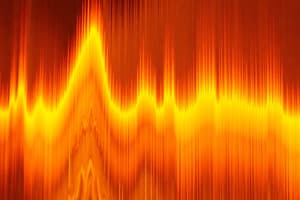Podcast
Questions and Answers
Which functional group is indicated by a strong, broad peak around 3200-3600 cm⁻¹ in an IR spectrum?
Which functional group is indicated by a strong, broad peak around 3200-3600 cm⁻¹ in an IR spectrum?
- Alkenes
- Carboxylic acids
- Amines
- Alcohols (correct)
What does a sharp peak around 3300-3500 cm⁻¹ in an IR spectrum usually represent?
What does a sharp peak around 3300-3500 cm⁻¹ in an IR spectrum usually represent?
- Aldehydes
- Nitriles
- Alkanes
- Amines (correct)
In which region of the IR spectrum would you expect to find the absorption peak indicative of a C=O functional group?
In which region of the IR spectrum would you expect to find the absorption peak indicative of a C=O functional group?
- 2000-1500 cm⁻¹ (correct)
- 4000-2500 cm⁻¹
- 1500-400 cm⁻¹
- 2500-2000 cm⁻¹
What is the significance of the fingerprint region in an IR spectrum?
What is the significance of the fingerprint region in an IR spectrum?
What common pitfall might occur when interpreting IR spectra?
What common pitfall might occur when interpreting IR spectra?
Flashcards are hidden until you start studying
Study Notes
Interpretation of IR Spectra
-
Infrared Spectroscopy Basics
- Technique used to identify functional groups in organic compounds.
- Based on the absorption of infrared light, causing molecular vibrations.
-
Key Regions of the Spectrum
- 4000-2500 cm⁻¹: O-H and N-H stretches.
- 2500-2000 cm⁻¹: Triple bonds (alkynes).
- 2000-1500 cm⁻¹: Double bonds (alkenes and carbonyls).
- 1500-400 cm⁻¹: Fingerprint region; complex vibrations.
-
Common Functional Group Absorption
- O-H: Strong, broad peak around 3200-3600 cm⁻¹ (alcohols, phenols).
- N-H: Sharp peaks around 3300-3500 cm⁻¹ (amines, amides).
- C=O: Strong peak around 1700 cm⁻¹ (ketones, aldehydes, carboxylic acids).
- C-H: Peaks around 2850-2960 cm⁻¹ (alkanes).
- C=C: Absorption around 1620-1680 cm⁻¹ (alkenes).
-
Peak Intensity and Shape
- Intensity: Reflects the concentration of the functional group.
- Shape: Broad peaks indicate hydrogen bonding; sharp peaks indicate isolated groups.
-
Fingerprint Region
- Located below 1500 cm⁻¹; unique to each compound.
- Useful for identifying and comparing compounds.
-
Interpreting Complex Spectra
- Analyze major peaks first to identify key functional groups.
- Compare the spectrum with known reference spectra.
- Consider the context of the sample (e.g., possible mixtures or solvents).
-
Common Pitfalls
- Overlapping peaks can complicate interpretation.
- Failure to recognize solvent effects can lead to misinterpretation.
- Misidentifying peaks; always verify with literature.
-
Practical Steps for Interpretation
- Obtain a clean IR spectrum of the sample.
- Identify and label significant peaks.
- Compare with standard reference data.
- Consider the molecular structure and expected functional groups.
- Document findings clearly and correlate with other analytical methods if necessary.
Infrared Spectroscopy Basics
- A technique for identifying functional groups in organic compounds by analyzing infrared light absorption.
- Molecular vibrations are induced through absorption, aiding in chemical identification.
Key Regions of the Spectrum
- 4000-2500 cm⁻¹: Characterized by O-H and N-H stretching vibrations.
- 2500-2000 cm⁻¹: Absorption due to triple bonds, particularly in alkynes.
- 2000-1500 cm⁻¹: This range highlights double bonds, including alkenes and carbonyl compounds.
- 1500-400 cm⁻¹: Known as the fingerprint region, where complex vibrational patterns occur that are unique to each substance.
Common Functional Group Absorption
- O-H: Displays a strong, broad peak around 3200-3600 cm⁻¹, typical of alcohols and phenols.
- N-H: Exhibits sharp peaks in the range of 3300-3500 cm⁻¹, found in amines and amides.
- C=O: A key absorption peak at approximately 1700 cm⁻¹, identified in ketones, aldehydes, and carboxylic acids.
- C-H: Peaks appear around 2850-2960 cm⁻¹, common in alkanes.
- C=C: Absorption around 1620-1680 cm⁻¹, indicative of alkenes.
Peak Intensity and Shape
- Intensity: The strength of absorption peaks correlates with the concentration of the functional groups present.
- Shape: Broad peaks suggest the presence of hydrogen bonding, while sharp peaks indicate isolated functional groups.
Fingerprint Region
- Found below 1500 cm⁻¹, this region is distinctive for each compound and critical for compound identification and comparison.
Interpreting Complex Spectra
- Begin by analyzing the most prominent peaks to ascertain major functional groups.
- Compare the obtained spectrum with known reference spectra to confirm findings.
- Context matters; consider sample characteristics like mixtures or solvents that may influence the spectrum.
Common Pitfalls
- Overlapping peaks can lead to challenges in interpretation and require careful analysis.
- Solvent effects must be recognized to avoid misinterpretation of results.
- Peaks should be verified against literature to prevent misidentification.
Practical Steps for Interpretation
- Start with a clean IR spectrum of the sample for clarity.
- Identify and label significant peaks meticulously.
- Compare identified peaks with standard reference data for reliability.
- Take into account the expected molecular structure and corresponding functional groups.
- Document all findings comprehensively and correlate with additional analytical methods for validation.
Studying That Suits You
Use AI to generate personalized quizzes and flashcards to suit your learning preferences.




